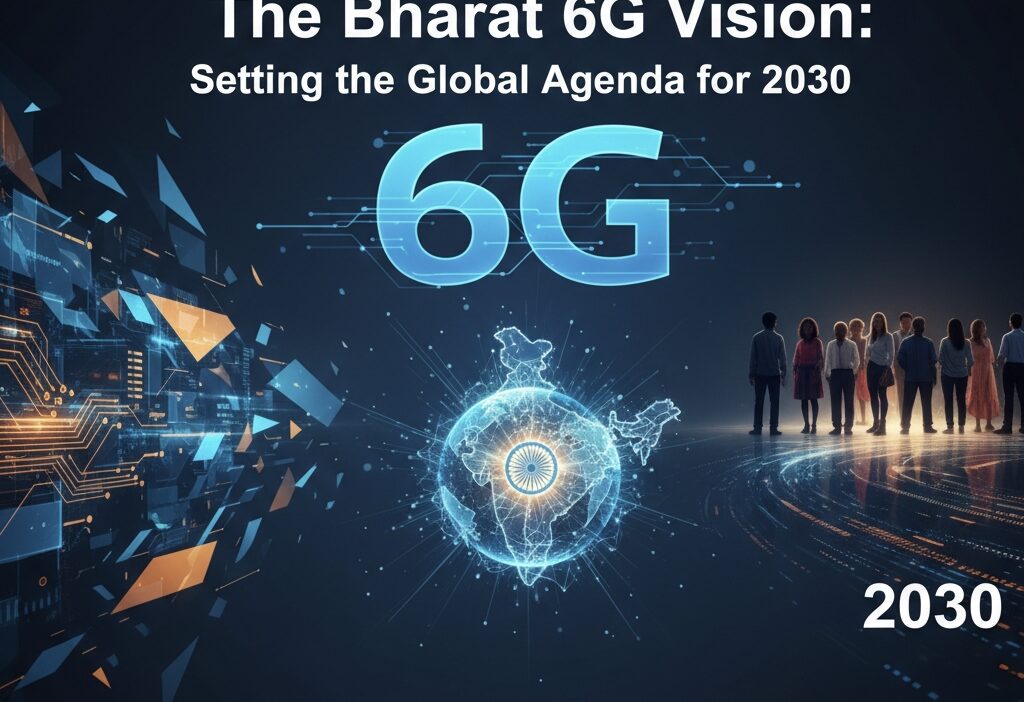Are You Ready for 1,000x Faster Internet?
When you hear “6G,” you probably think of faster downloads. But imagine a world where the internet is not just fast, but ubiquitous—a network so intelligent it can see, sense, and heal itself. Imagine a world where a remote village in the Himalayas gets the same connectivity quality as a high-rise in Bengaluru.
That isn’t a science fiction fantasy; it is the core promise of the Bharat 6G Vision, and this week, as the India Mobile Congress (IMC) 2025 gets underway, the world is watching. India is aggressively shifting from a follower in telecom to a global leader, building a next-generation ecosystem from the chips up. This is the story of how India plans to transform its digital landscape by 2030, ensuring that the fruits of connectivity reach every citizen.
1. The Bharat 6G Vision: Setting the Global Agenda for 2030
India is not waiting for the world to define 6G; it’s co-authoring the blueprint. Launched in March 2023, the Bharat 6G Vision is a detailed roadmap with a clear target: Position India as a global leader in 6G technology by 2030.
This vision is anchored by two fundamental principles: affordability and ubiquity. Unlike previous generations primarily focused on urban profit, 6G is designed from the ground up to be a tool for socio-economic development across the entire nation.
Patents and Indigenous Power
The most significant marker of India’s commitment is its investment in intellectual property (IP).
- The government has funded over 111 research projects focused on crucial 6G technologies like Terahertz communication and advanced antennas.
- These efforts have propelled India into the top six countries globally in 6G patent filings—a remarkable achievement given its historical lag in previous telecom generations.
- Why this matters: A strong patent portfolio gives India influence in setting global 6G standards (IMT-2030) and ensures that the technology developed is scalable, secure, and tailored to the needs of the “Global South.”
2. 6G’s Promised Power: From Speed to Sensing
The leap from 5G to 6G is not just about raw bandwidth; it’s about unlocking entirely new capabilities that will reshape industries:
| Feature | 5G (Current) | 6G (Expected) | Real-World Impact |
| Peak Speed | Up to 10 Gbps | Up to 1 Terabit per second (Tbps) | Downloading over 100 HD movies per minute; seamless holographic communication. |
| Latency | 1 millisecond (ms) | Microsecond latency (less than 1 ms) | Enabling truly real-time applications like remote surgery and fully autonomous vehicle coordination. |
| Connectivity | 1 million devices/km² | 10 million devices/km² | Supporting hyper-dense Smart Cities and the massive scale of the Internet of Everything (IoE). |
| New Capability | Communication | Integrated Sensing and Communication (ISAC) | The network itself can sense the environment (e.g., track objects, map air quality) without dedicated sensors. |
| Network Core | Software-Defined | AI-Native | Networks will be self-optimizing, predicting outages, and allocating resources autonomously. |
This fusion of communication and sensing means the 6G network will not just connect us, but will turn the entire digital infrastructure into one massive, intelligent sensor.
3. Bridging the Gap: The Crucial Role of Satellite Communication (Satcom)
While terrestrial towers cover cities, they are economically unviable or physically impossible to build in India’s toughest terrains—from the remote Northeast to vast desert areas. This is where Satellite Communication (Satcom) becomes the ultimate equalizer.
- Seamless Coverage: Satcom is essential to achieving the “ubiquitous connectivity” goal of the Bharat 6G Vision. By granting licenses to players for satellite internet services, the government is ensuring that non-terrestrial networks (NTN) can seamlessly integrate with 6G and 5G.
- Disaster Resilience: Satellite links remain operational when terrestrial infrastructure is wiped out by floods or earthquakes, making them critical for disaster management and national security.
- Rural Empowerment: For the nearly half of India’s population still residing in rural areas (where internet penetration is lower), Satcom provides a quick, cost-effective way to get high-speed internet, unlocking access to remote education, telemedicine, and digital markets.
4. The Foundation: Securing India’s Semiconductor Future
The entire 6G and AI vision rests on one physical component: the chip. India learned the lesson of import dependency during global chip shortages, and the response is the bold India Semiconductor Mission (ISM), backed by a ₹76,000 crore (approx. 10 billion) outlay.
- Aatmanirbhar Chips: The core goal is national self-reliance (Aatmanirbharta) in electronics. By attracting global manufacturers and incentivizing domestic startups through schemes like the Design Linked Incentive (DLI), India is building its entire semiconductor ecosystem—from design to fabrication.
- The Milestones: India has already begun manufacturing its first indigenous chips, with multiple fabrication and OSAT (Outsourced Semiconductor Assembly and Test) units currently under construction.
- Strategic Advantage: By controlling the manufacturing of its own chips (especially advanced ones used in 6G and defence systems), India ensures security, controls costs, and establishes itself as a trusted and resilient partner in the global supply chain.
Conclusion: From Consumer to Contributor
The convergence of the Bharat 6G Vision, the strategic push for Satcom, and the Semiconductor Mission creates a powerful trifecta. The India Mobile Congress isn’t just a trade show; it’s a showcase of this integrated strategy.
India is no longer just a market for global tech products; it is becoming a contributor and an exporter of core technology. By focusing on indigenous development and ubiquitous coverage, India is laying the foundation not just for faster data speeds, but for true digital equality, aiming to power the next great wave of global innovation by 2030.




.jpg)
